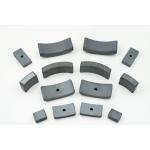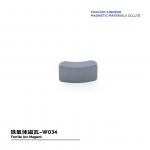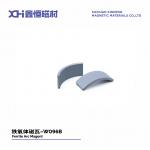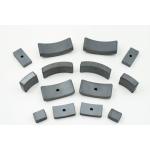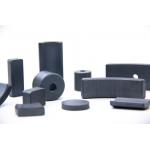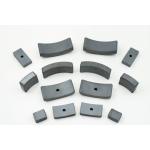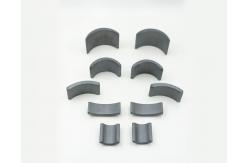Applied To Fine Permanent Magnet Ferrite In Advanced Automotive
Motors Company profile:
The company boasts the first domestically developed servo
fully-automatic wet press oil press machine and the first
dual-track roller kiln in the nation. It also possesses the
capability for independent design, development, and processing of
various types of molds.
The primary business of the company focuses on sintered ferrite
permanent magnet components, encompassing automotive motors,
motorcycle motors, general machinery motors, household appliance
motors, household fan motors, variable frequency motors, water pump
motors, and more. These products are widely used in the automotive,
motorcycle, office equipment, power tools, household appliances,
and fitness equipment industries.
What is permanent magnet ferrite?
Permanent magnet ferrite is a kind of magnetic ceramic material,
composed of iron oxides and rare earth elements. It has a high
magnetization and coercivity, so it is widely used in the
manufacture of various permanent magnet devices, such as magnets,
motors and sensors. Permanent magnet ferrite has good corrosion
resistance and high temperature resistance, so it has been widely
used in industrial and scientific fields.
Permanent magnet ferrite is a type of magnet that is made from a
material called ferrite, which is a type of ceramic compound
composed of iron oxide (Fe2O3) combined with other metallic
elements such as barium, strontium, or lead. This combination of
materials creates a magnetic material with strong permanent
magnetism. Permanent magnet ferrite is commonly used in various
applications such as electric motors, speakers, and magnetic
assemblies.
What's the application of Xinheng's permanent ferrite magnets?
Xinheng mainly manufactures the following types of ceramic arc
segment magnets: - Motors and generators: Permanent magnet ferrites are commonly used
in the manufacture of various types of motors and generators,
including wind turbines, electric vehicle drive motors, and motors
in medical equipment. Because permanent magnet ferrite has high
permeability and stable magnetic properties, it can improve the
efficiency and performance of motors and generators.
- Magnetic sensors: Permanent magnet ferrites can be used to produce
various types of magnetic sensors, such as speed sensors, position
sensors, Angle sensors, etc. These sensors are widely used in
automotive, industrial automation, aerospace and other fields.
- Magnetic material application: permanent magnet ferrite can also be
used to manufacture various types of magnetic materials, such as
magnets, magnetic adsorption materials, etc. These materials have
important applications in household appliances, medical equipment,
magnetic products and so on.
- Magnetic energy storage components: permanent magnet ferrite can
also be used to manufacture magnetic energy storage components,
such as transformers, inductors, etc. These components play an
important role in power systems, communication systems, and
electronic equipment.
- Other applications: permanent magnet ferrite can also be used in
magnetic recording materials, magnetic refrigeration materials and
other fields, with a wide range of application prospects and market
demand.
PHYSICAL PROPERTIES OF SINTERED FERRITE MAGNETS | | Units | Sintered Ferrite (Ceramic) | | Curie Temperature | ºC | 450 | | Maximum Operating Temperature | ºC | 350 | | Hardness | Hv | >530 | | Density | g/cm3 | 4.8 – 5.0 | | Relative recoil permeability | μrec | 1.05-1.1 | | Temperature Coefficient Br | %/ºC | -0.18 | | Temperature Coefficient iHc | %/ºC | 0.11-0.40 | | Anti-Bending Strength | N/m2 | (0.5-0.9)×108 | | Anti-Compressive Strength | N/m2 | ≥6.9×108 | | Anti-Tensile Strength | N/m2 | (0.2-0.5)×108 | | Specific Heat | J/kg·K | 600-900 | | Resistivity | Q.cm | >104 |
What's the feature of ceramic strontium ferrite magnet made by wet
compression molding?
- Composition - Contain strontium ferrite (SrFe12O19) as the primary
magnetic material. Strontium ferrite has good magnetic properties
and is inexpensive to produce.
- Density - Have a high relative density of around 95% or more after
sintering. This gives good mechanical strength.
- An-isotropy - Exhibit strong magnetocrystalline an-isotropy due to
their hexagonal crystal structure. This results in a preferred
direction of magnetization along one axis.
- Particle shape - The strontium ferrite powder used typically has a
hexagonal platelet morphology which helps promote magnetic
an-isotropy during molding and sintering.
- Molding method - The powder is mixed with a liquid binder and
compression molded into a dense green compact using high pressures.
This orients the an-isotropic particles.
- Firing process - The compact is then sintered at high temperature
to develop density while preserving the induced magnetic anisotropy
orientation from molding.
- Remanence - Have a maximum magnetic flux density or remanence along
the axis of anisotropy, but little/no remanence perpendicular to
it.
- Coercivity - Usually have medium to high coercivity depending on
additives, density, and anisotropy level achieved.
FERRITE POWDER GRADE OF UNIVERSAL MOTORS MAGNET | Grade | Br(mT) | Hcb(KA/m) | Hcj(KA/m) | (BH)max(KJ/m3) | | mT | Gs | KA/m | Oe | KA/m | Oe | KJ/m3 | MGOe | | Y30H-1 | 380-400 | 3800-4000 | 230-275 | 2890-3460 | 235-290 | 2950-3640 | 27.0-32.5 | 3.4-4.1 | | Y33 | 410-430 | 4100-4300 | 220-250 | 2760-3140 | 225-255 | 2830-3200 | 31.5-35.0 | 3.9-4.4 | | Y33H | 410-430 | 4100-4300 | 250-270 | 3140-3390 | 250-275 | 3140-3450 | 31.5-35.0 | 3.9-4.4 | | Y35 | 430-450 | 4300-4500 | 215-239 | 2700-3000 | 217-241 | 2730-3030 | 33.1-38.2 | 4.1-4.8 |
|
